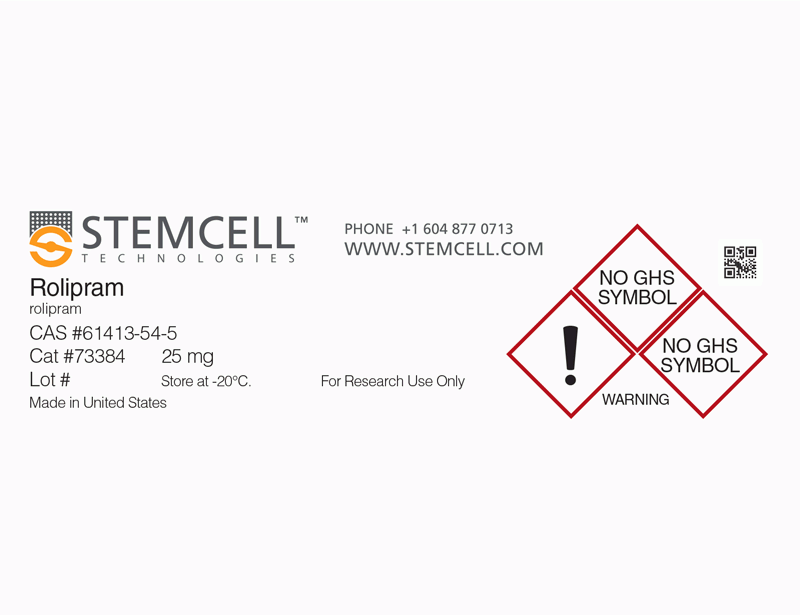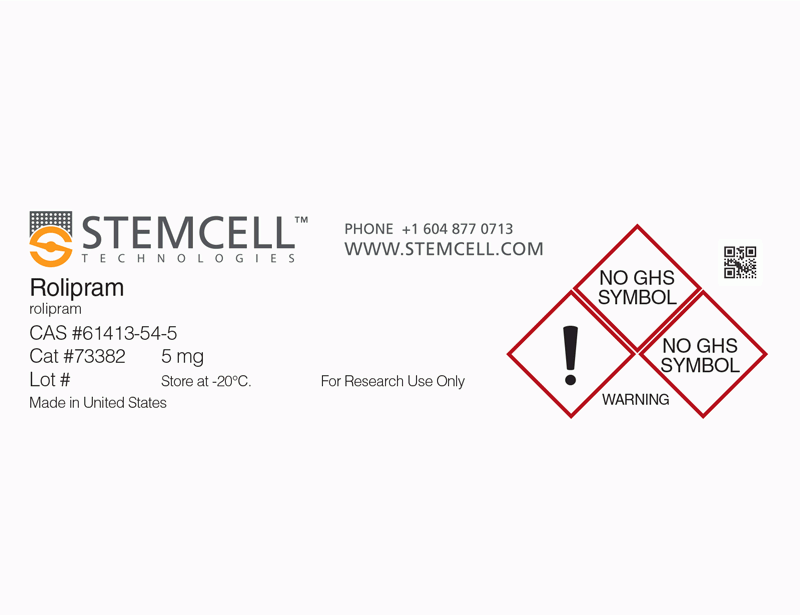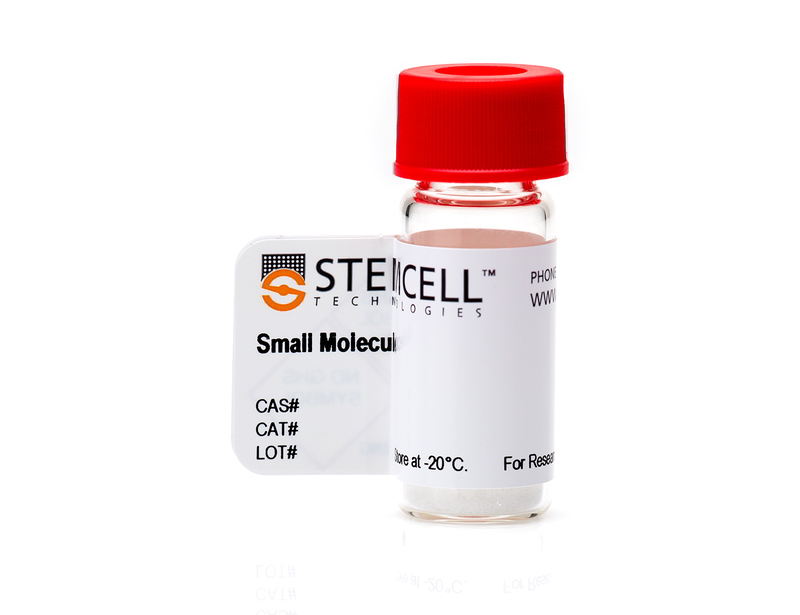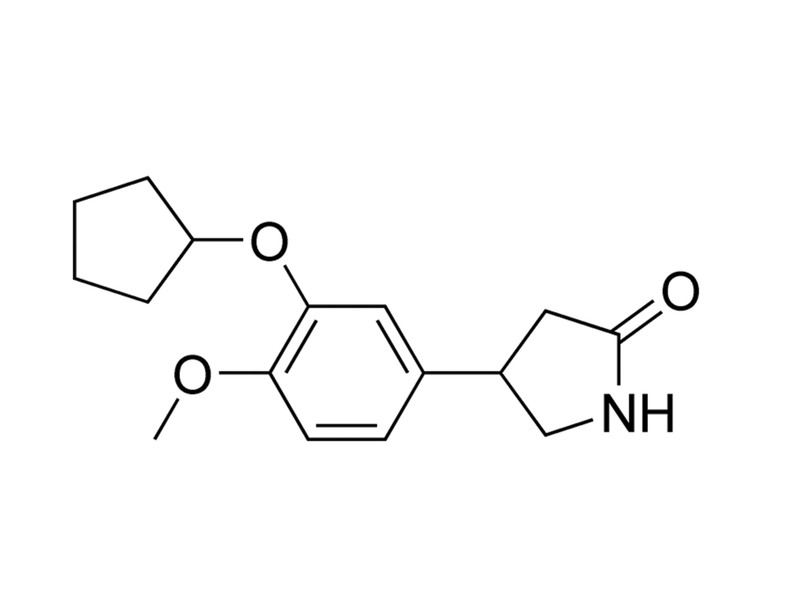Rolipram
cAMP pathway activator; Inhibits type 4 cyclic nucleotide phosphodiesterases (PDE4)
概要
Rolipram is a cell-permeable, selective inhibitor of Type 4 cyclic nucleotide phosphodiesterases (PDE4), which mediate cyclic AMP (cAMP) degradation. Rolipram preferably inhibits PDE4 isoform A (IC₅₀ = 3 nM) over other isoforms such as B and D (IC₅₀ = 130 and 240 nM respectively; MacKenzie & Houslay). It inhibits interferon (IFN)-γ stimulated phosphorylation of p38 mitogen-activated protein (MAP) kinase through PDE4B and/or PDE4D isoform inhibition (MacKenzie & Houslay).
DIFFERENTIATION
· Enhances osteoblastic differentiation of mouse mesenchymal stem cells (MSCs) induced by BMP-2 (Munisso et al.)
· Induces neural differentiation of human bone marrow-derived MSCs (Alexanian et al.)
REPROGRAMMING
· Induces reprogramming of adult human dermal fibroblasts (AHDFs) into induced neuronal stem cells, in combination with A83-01, CHIR99021, sodium butyrate, LPA, SP600125, and exogenous OCT4 expression (Zhu et al.)
DISEASE MODELING
· Promotes survival of newly formed mouse hippocampal neurons in a mouse model of ischemia (Sasaki et al.)
· Reverses amphetamine-induced reductions in auditory-evoked potentials in a C57BL/6J mouse model of schizophrenia (Maxwell et al.)
IMMUNOLOGY
· Inhibits inflammation by suppressing leukocyte function, inhibiting C5a-stimulated leukotriene C4 (LTC4) synthesis in human eosinophils (Tenor et al.)
· Inhibits lipopolysaccharide (LPS)-induced tumor necrosis factor (TNF) synthesis in human monocytes (Souness et al.)
DIFFERENTIATION
· Enhances osteoblastic differentiation of mouse mesenchymal stem cells (MSCs) induced by BMP-2 (Munisso et al.)
· Induces neural differentiation of human bone marrow-derived MSCs (Alexanian et al.)
REPROGRAMMING
· Induces reprogramming of adult human dermal fibroblasts (AHDFs) into induced neuronal stem cells, in combination with A83-01, CHIR99021, sodium butyrate, LPA, SP600125, and exogenous OCT4 expression (Zhu et al.)
DISEASE MODELING
· Promotes survival of newly formed mouse hippocampal neurons in a mouse model of ischemia (Sasaki et al.)
· Reverses amphetamine-induced reductions in auditory-evoked potentials in a C57BL/6J mouse model of schizophrenia (Maxwell et al.)
IMMUNOLOGY
· Inhibits inflammation by suppressing leukocyte function, inhibiting C5a-stimulated leukotriene C4 (LTC4) synthesis in human eosinophils (Tenor et al.)
· Inhibits lipopolysaccharide (LPS)-induced tumor necrosis factor (TNF) synthesis in human monocytes (Souness et al.)
Alternative Names
SB 95952; ZK 62711
Cell Type
Mesenchymal Stem and Progenitor Cells, Monocytes, Neural Stem and Progenitor Cells, Neurons, Osteoblasts
Species
Human, Mouse, Rat, Non-Human Primate, Other
Application
Differentiation, Reprogramming
Area of Interest
Disease Modeling, Immunology, Stem Cell Biology
CAS Number
61413-54-5
Chemical Formula
C₁₆H₂₁NO₃
Molecular Weight
275.3 g/mol
Purity
≥ 98%
Pathway
cAMP
Target
PDE
技术资料
| Document Type | 产品名称 | Catalog # | Lot # | 语言 |
|---|---|---|---|---|
| Product Information Sheet | Rolipram | 73382, 73384 | All | English |
| Safety Data Sheet | Rolipram | 73382, 73384 | All | English |
数据及文献
Publications (8)
Cell research 2014
Small molecules enable OCT4-mediated direct reprogramming into expandable human neural stem cells.
Abstract
Abstract
Biochimie 2012
Cilomilast enhances osteoblast differentiation of mesenchymal stem cells and bone formation induced by bone morphogenetic protein 2.
Abstract
Abstract
A rapid and efficient method to stimulate bone regeneration would be useful in orthopaedic stem cell therapies. Rolipram is an inhibitor of phosphodiesterase 4 (PDE4), which mediates cyclic adenosine monophosphate (cAMP) degradation. Systemic injection of rolipram enhances osteogenesis induced by bone morphogenetic protein 2 (BMP-2) in mice. However, there is little data on the precise mechanism, by which the PDE4 inhibitor regulates osteoblast gene expression. In this study, we investigated the combined ability of BMP-2 and cilomilast, a second-generation PDE4 inhibitor, to enhance the osteoblastic differentiation of mesenchymal stem cells (MSCs). The alkaline phosphatase (ALP) activity of MSCs treated with PDE4 inhibitor (cilomilast or rolipram), BMP-2, and/or H89 was compared with the ALP activity of MSCs differentiated only by osteogenic medium (OM). Moreover, expression of Runx2, osterix, and osteocalcin was quantified using real-time polymerase chain reaction (RT-PCR). It was found that cilomilast enhances the osteoblastic differentiation of MSCs equally well as rolipram in primary cultured MSCs. Moreover, according to the H89 inhibition experiments, Smad pathway was found to be an important signal transduction pathway in mediating the osteogenic effect of BMP-2, and this effect is intensified by an increase in cAMP levels induced by PDE4 inhibitor.
Neurorehabilitation and neural repair 2011
Transplanted neurally modified bone marrow-derived mesenchymal stem cells promote tissue protection and locomotor recovery in spinal cord injured rats.
Abstract
Abstract
BACKGROUND: Stem cell-based therapy for repair and replacement of lost neural cells is a promising treatment for central nervous system (CNS) diseases. Bone marrow (BM)-derived mesenchymal stem cells (MSCs) can differentiate into neural phenotypes and be isolated and expanded for autotransplantation with no risk of rejection. OBJECTIVE: The authors examined whether transplanted neurally induced human MSCs (NI hMSCs), developed by a new procedure, can survive, differentiate, and promote tissue protection and functional recovery in injured spinal cord (ISC) rats. METHODS: Neural induction was achieved by exposing cells simultaneously to inhibitors of DNA methylation, histone deacetylation, and pharmacological agents that increased cAMP levels. Three groups of adult female Sprague-Dawley rats were injected immediately rostral and caudal to the midline lesion with phosphate-buffered saline, MSCs, or NI hMSCs, 1 week after a spinal cord impact injury at T-8. Functional outcome was measured using the Basso Beattie Bresnahan (BBB) locomotor rating scale and thermal sensitivity test on a weekly basis up to 12 weeks postinjury. Graft integration and anatomy of spinal cord was assessed by stereological, histochemical, and immunohistochemical techniques. RESULTS: The transplanted NI hMSCs survived, differentiated, and significantly improved locomotor recovery of ISC rats. Transplantation also reduced the volume of lesion cavity and white matter loss. CONCLUSION: This method of hMSC modification may provide an alternative source of autologous adult stem cells for CNS repair.
Stroke; a journal of cerebral circulation 2007
The phosphodiesterase inhibitor rolipram promotes survival of newborn hippocampal neurons after ischemia.
Abstract
Abstract
BACKGROUND AND PURPOSE: Brain ischemia stimulates neurogenesis. However, newborn neurons show a progressive decrease in number over time. Under normal conditions, the cAMP-cAMP responsive element binding protein (CREB) pathway regulates the survival of newborn neurons. Constitutive activation of CREB after brain ischemia also stimulates hippocampal neurogenesis. Thus, activation of cAMP-CREB signaling may provide a promising strategy for enhancing the survival of newborn neurons. We examined whether treatment of mice with the phosphodiesterase-4 inhibitor rolipram enhances hippocampal neurogenesis after ischemia. METHODS: Both common carotid arteries in mice were occluded for 12 minutes. Bromodeoxyuridine (BrdU) was used to label proliferating cells. Mice were perfused transcardially with 4% paraformaldehyde, and immunohistochemistry was performed. To evaluate the role of CREB in the survival of newborn neurons after ischemia, intrahippocampal injection of a CRE-decoy oligonucleotide was delivered for 1 week. We examined whether the activation of cAMP-CREB signaling by rolipram enhanced the proliferation and survival of newborn neurons. RESULTS: Phospho-CREB immunostaining was markedly upregulated in immature neurons, decreasing to low levels in mature neurons. The number of BrdU-positive cells 30 days after ischemia was significantly less in the CRE-decoy treatment group than in the vehicle group. Rolipram enhanced the proliferation of newborn cells under physiologic conditions but not under ischemic conditions. Rolipram significantly increased the survival of nascent BrdU-positive neurons, accompanied by an enhancement of phospho-CREB staining and decreased newborn cell death after ischemia. CONCLUSIONS: CREB phosphorylation regulates the survival of newborn neurons after ischemia. Chronic pharmacological activation of cAMP-CREB signaling may be therapeutically useful for the enhancement of neurogenesis after ischemia.
Neuroscience 2004
Phosphodiesterase inhibitors: a novel mechanism for receptor-independent antipsychotic medications.
Abstract
Abstract
OVERVIEW: All current antipsychotic medications work by binding to Gi-coupled dopamine (DA) D2 receptors. Such medications are thought to affect cellular function primarily by decreasing DA-mediated regulation of intracellular cyclic adenosine monophosphate (cAMP).However, several studies indicate that cAMP signal transduction abnormalities in schizophrenia may not be limited to D2-containing cells. The current study examines the potential of using non-receptor-based agents that modify intracellular signal transduction as potential antipsychotic medications. METHODS: The indirect DA agonist amphetamine has been used to model the auditory sensory processing deficits in schizophrenia. Such pharmacologically induced abnormalities are reversed by current antipsychotic treatments. This study examines the ability of the phosphodiesterase-4 inhibitor, rolipram, to reverse amphetamine-induced abnormalities in auditory-evoked potentials that are characteristic of schizophrenia. RESULTS: Rolipram reverses amphetamine-induced reductions in auditory-evoked potentials. CONCLUSION: This finding could lead to novel approaches to receptor-independent treatments for schizophrenia.
The Biochemical journal 2000
Action of rolipram on specific PDE4 cAMP phosphodiesterase isoforms and on the phosphorylation of cAMP-response-element-binding protein (CREB) and p38 mitogen-activated protein (MAP) kinase in U937 monocytic cells.
Abstract
Abstract
U937 monocytic cells are shown here to express a range of PDE4, cAMP-specific phosphodiesterase (PDE) isoenzymes: the long isoenzymes, PDE4A4, PDE4D5 and PDE4D3, plus the short isoenzyme, PDE4B2. These isoenzymes provide around 76% of the total cAMP PDE activity of U937 cells. The specific activities of the total PDE4A, PDE4B and PDE4D activities were 0.63+/-0.09, 8.8+/-0.2 and 34.4+/-2.9 pmol/min per mg of protein respectively. The PDE4 selective inhibitor, rolipram, inhibited immunopurified PDE4B and PDE4D activities similarly, with IC(50) values of approx. 130 nM and 240 nM respectively. In contrast, rolipram inhibited immunopurified PDE4A activity with a dramatically lower IC(50) value of around 3 nM. Rolipram increased phosphorylation of cAMP-response-element-binding protein (CREB) in U937 cells in a dose-dependent fashion, which implied the presence of both high affinity (IC(50) value approx. 1 nM) and low affinity (IC(50) value approx. 120 nM) components. Rolipram dose-dependently inhibited the interferon-gamma (IFN-gamma)-stimulated phosphorylation of p38 mitogen-activated protein (MAP) kinase in a simple monotonic fashion with an IC(50) value of approx. 290 nM. On this basis, it is suggested that rolipram inhibition of PDE4A4 is involved in regulating CREB phosphorylation but not IFN-gamma-stimulated p38 MAP kinase phosphorylation. PDE4A4 was also selectively activated by challenge of U937 cells with either bacterial lipopolysaccharide (LPS) or IFN-gamma through a process which was attenuated by both wortmannin and rapamycin. It is proposed that the PDE4A4 isoform is involved in compartmentalized cAMP signalling responses in U937 monocytes.




